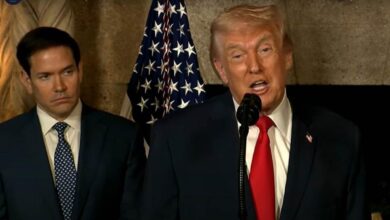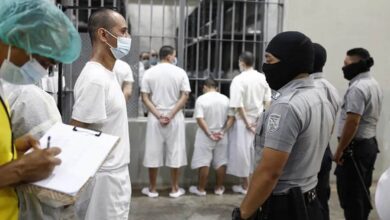With 105 votes in favor and only 19 against, on November 9, Martín Vizcarra Cornejo was removed from the presidency of the Republic of Peru .

We explain how the process that ended with the dismissal of Martín Vizcarra as president of Peru came about. / Photo: Reuters
LatinAmerican Post | Jorge Francisco Vuelvas Lomeli
Listen to this article
Leer en español: Línea de tiempo de la destitución del presidente de Perú
This, under the figure of "vacancy due to moral incapacity", motivated by the alleged acts of corruption committed by Vizcarra when he was governor, when, according to the Congress of the Republic, he received 1,300,000 soles (359,000 USD) in bribes from a group of construction companies called "the construction cartel".
But how did the events of the impeachment occur? What was the genesis of this crisis? Here is a timeline where the removal process is explained.
What happened before the crisis?
On March 23, 2018, Martín Vizcarra took office as the sixty-seventh Constitutional President of the Republic of Peru, which he assumed in an environment of political instability, due to the resignation of Pedro Pablo Kuczynski. From that moment, the former vice president would submit to the same pressures as his predecessor, entering an arena of conflict with the Congress of the Republic.
On September 30, 2019, after several political blockades and cabinet appointments, Vizcarra dissolved the Congress of the Republic of Peru, arguing moral incapacity on the part of the legislators, who were mostly from the opposition group called Fujimori.
On January 26, 2020, the extraordinary elections called by Martín Vizcarra were held, who hoped to have a Congress more attached to his political agenda and devoid of Fujimori opposition. However, the new Congress of the Republic was fragmented between nine parties, where most of them had political positions contrary to those of then-President Vizcarra.
On September 18, 2020, the Peruvian Congress voted on a vacancy motion, for alleged irregularities committed by Vizcarra in the hiring of a ministerial motivational coaching musician (Richard Swing case). This motion was rejected by the majority of the legislators, after a speech by Vizcarra before the Congress of the Republic.
Also read: What are Biden's main promises to Latinos?
The new and effective removal of Vizcarra
The political hecatomb that is being experienced in Peru is an accumulation of events in the Richard Swing case and the alleged bribes received by Vizcarra from the Construction Cartel. In addition to this, Peru is in an economically unfavorable situation, since Vizcarra's coronavirus isolation policies represented enormous economic losses to Peruvian families. Due to these two things, congress began considering his dismissal again.
All of the above occurs in a context in which Vizcarra had gained enormous popularity due to an agenda that apparently fought head-on against the corruption that prevails in the country, where various congressmen were pointed out to be involved. This not only rekindled existing tensions with the congressmen, but Vizcarra was subjected to a second impeachment attempt for moral incapacity.
On Monday, November 2 of this year, the Congress of the Republic of Peru began a new impeachment process; This procedure was endorsed with the vote in favor of 60 deputies, 40 against and 18 abstentions. With this, the former president was formally summoned to present his evidence and means of defense.
On November 4, 2020, a request was presented in the same Congress that advanced the appearance of President Vizcarra to Friday, November 6 of the current year. However, said request was rejected by the Board of Directors of the Congress of the Republic of Peru.
Thus, on November 9 of this year, the now-former president of Peru, Martín Vizcarra, appeared before the assembly to exercise his right of defense and show the arguments that tried to convince the legislators that the impeachment process was unfounded. However, that same day the legislators debated the impeachment process for almost 6 hours, which was approved by 105 votes of the legislators present.
The day after the event, Vizcarra addressed the nation with a speech in which he accepted his dismissal, highlighting that "history and the Peruvian people will judge Congress." That same November 10, the President of the Congress of the Republic of Peru, Manuel Merino, was sworn in as the third president of Peru in the last 4 years, since the Constitution of the Country considers this position as the next in the line of succession.
After the crisis came the tragedy
However, despite the fact that Congress expected this to be the final chapter of the five-year period that resumed the political crisis in Peru, what happened was a resurgence of protests against Congress, arguing that the actions against Vizcarra were a gamble, a policy that only sought to take over the government.
For this reason, this weekend was plagued with protests in the streets of Lima, where protesters hailed the creation of a new constitution, which would prevent Congress from unfoundedly dismissing the current president.
Faced with the wave of protests that left 2 dead and several missing, Manuel Merino went down in history as the President who lasted the least time in office, since on November 15, 2020 he presented his resignation, after pressure from the same Congress that had allowed their incorporation.
Faced with this scenario, on November 15 a power vacuum was maintained, as there was no one to lead the government of the Republic of Peru. However, on November 16 of this year, after an intense debate in Congress, Francisco Sagasti was elected as the new President of Peru, in order to complete the remaining months of Vizcarra, and lead the country to elections which are scheduled in early 2021.
Also read: What happened to Evo Morales in Bolivia after the elections?
Political future uncertain
In this context, Peruvian politics is positioned as a whirlwind of instability, where the unknowns for the next presidential elections multiply since the country in question has been characterized by the recurrent dismissal and trial of its former presidents. However, the removal of Vizcarra causes particular indignation among the Peruvian population, firstly because he undertook a campaign to combat corruption that was so demanded in the country, and secondly because acts of bribery and conflict of interest are attributed only by The congress.
Thus, it will be up to the Judicial Power of Peru to rule on the future of the now-former president Vizcarra, who is under public scrutiny and as the protagonist of one of the biggest scandals in Peruvian politics in recent years.
All of the above has its origin in a Peruvian Constitution that does not define whether its political system is presidential or parliamentary; For this reason, it is worth reflecting on the importance of drafting a new constitutional text, where the parliament does not have excess power, and cannot be removed by the President of the Republic. In addition to this, it is necessary to reflect on the importance of a bicameral system, since having a single legislative chamber makes the paralysis of the government more likely.




